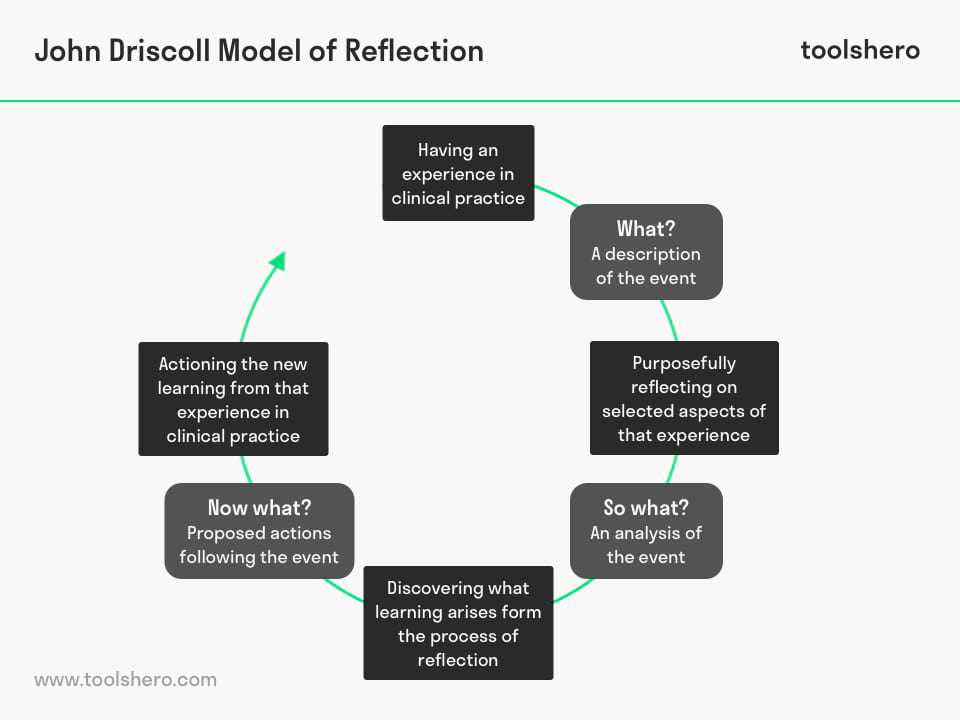John Driscoll Model of Reflection

John Driscoll Model of Reflection: this article provides a practical explanation of the John Driscoll Model of Reflection, developed by John Driscoll. Next to what it is, this article also highlights the steps, the practice, consequences of a reflective work method, the needed skills, attributes and tips. After reading this article, you’ll understand the basics of this and personal development and reflection tool. Enjoy reading!
What is the John Driscoll Model of Reflection?
The John Driscoll Model of Reflection is a framework for reflection, developed into a structured process to guide reflection.
There are several models of reflection and there isn’t one right choice. It’s important to choose the model that matches the person who will be using it.
The John Driscoll Model of Reflection is based on the three stem questions by Terry Borton, developed in 1970. These are:
- What?
- So what?
- Now what?
Driscoll connected these three stem questions to the stages of an experience learning cycle, and then added trigger questions that must be answered to complete the reflection cycle. The three questions were developed in 1994, 2000 and 2007. The John Driscoll Model of Reflection is one of the simplest models of reflection.

Figure 1 – ohn Driscoll Model of Reflection cycle
By answering these three questions, you can start to analyse experiences and learn from these. First, it’s important to describe what the situation or experience was like.
The context is essential. This gives the user a more complete idea of what is going on. This is achieved by thinking about the ‘what’ question? What was learnt from the experience? The last phase encourages the user to think about the action that is taken as a result of the reflection.
Should behaviour be changed? Must something new be introduced? Or is the status quo sufficiently positive, which means no changes are needed?
Step 1: what?
To complete the first step of the structured reflection, the following questions must be answered:
- Briefly describe the experience/situation/incident you will be reflecting on
- What exactly happened?
- What exactly did you do?
- Was someone else involved?
- Was it a good experience? Or bad? Or both? And why?
Step 2: so what?
To complete the second step of the structured reflection, the following questions must be answered:
- How did you feel at that specific moment?
- How you react?
- Why did you react this way?
- Did you feel the same about the situation then as you do now?
- Were you experiencing a conflict with your personal values?
- Do you think past situations have influenced your experience during this situation?
- Who else was involved? How did they feel? And how did they react? And why did they react this way?
Step 3: now what?
To complete the third step of the structured reflection, the following questions must be answered:
- What have you learnt from reflecting on this situation/experience/incident?
- Could you have prevented negative outcomes?
- And how could you have done so?
- What would you do differently if a similar situation were to occur in the future?
- What could you do to better prepare yourself for this?
- Where did it go wrong last time and what will you focus on now?
Thinking about the practice
The models and theories of reflection are often aimed at teachers. That makes sense, as they are the ones who must transfer this knowledge to others. The John Driscoll Model of Reflection helps teachers, but others involved as well, to stay engaged in the work of academics.
An important aspect to be able to do this is to keep track of activities. This is necessary to allow for evaluation and to create a learning moment. By addressing the disadvantages of a certain method, new ways can be found to solve problems.
Reflective practice is often viewed as a choice for professionals whether or not to engage in reflection about their work. But in reality, all practitioners in all sectors think about their professional lives.
In his research, Driscoll posits that, when he investigates whether or not someone is already reflecting in practice, he would probably establish that this person constantly thinks about what he or she is doing.
Thinking about an experience, so he says, is a competent and deliberate activity that demands the capacity to analyse practical situations and judge the effectiveness of methods. What is usually viewed as reflection, is not reflection in essence at all.
Considering an experience or event is often not targeted and rarely leads to necessary or new ways of thinking or acting in practice. That is what reflective action represents.
Why is change caused by reflection emphasised so strongly in the study?
In Driscoll’s research, he also discusses why change through reflection is emphasised so strongly. He refers to fellow researcher Jarvis when he pleads in favour of the need for a reflective practice because nurses deal with people who cause them to responsively and reflectively carry out their tasks due to their individual character, rather than simply perform these task routinely.
He also refers to Cox et al. A study from 1994 demonstrates that nurses, just like other people in all aspects of their life, don’t always think about their actions in detail. As a result, these nurses are reproached for working on auto pilot, where fixed patterns are followed that direct their actions.
Using the John Driscoll Model of Reflection for reflective writing
The John Driscoll Model of Reflection is so simple that it can also easily be used to learn reflective writing. The model is very useful and has been present long enough to train reflective writing.
The reason for this is that this model helps the writer to organise his or her document more constructively and succinctly. Merely the same three questions are needed to write a well-structured and succinct document. Focus on these three questions.
To prevent making mistakes in the future and to prevent accidents, a good analogy with the past must exist. By identifying and analysing past mistakes, people can make sure that similar situations can be better addressed in the future.
Complete Personal Development and Transformation Course
John Driscoll Model of Reflection: consequences of a reflective work method
In the study where John Driscoll elaborates on this theory about this subject, he names several consequences and conditions of ‘reflective practice’. He also refers to Bulman who suggests that reflection forces practitioners to face incongruities and awkwardness. This study was done in the context of the nursing sector at that time.
Furthermore, he states that reflection is a deliberate event that takes both time and dedication. ‘Why did you do that?’ is probably the most important question. Answering that question is part of the conditions that are needed for regular critical reflection in practice. The alternative question is: ‘why did you choose to do nothing?’
Several other examples of reflective employees in practice (from the nursing sector) are:
- Improves the group instead of competing with traditional forms of knowledge about something specific
- Can generate practice-based knowledge because it’s based on real practice
- Values what colleagues do and understands why they do it
- Can help others to gain better insight into tricky and complex exercises
- Can support others by offering them the opportunity to talk
- Puts improvement of patient care first
- Encourages others to find ways of becoming more effective and to improve in practice
- Offers a practical learning activity that can contribute to the training of other professionals
- Offers an investigative and evidence-based approach
The conditions, or part of the burdens to become reflective are:
- Finding the time to participate in this process
- Distinguishing from the masses
- Challenging conformity in practice
- Often a lonely voice
- Being less satisfied with the way the work is being done
- Wanting to know more about why things are done a certain way
- Being called a troublemaker
- Suggesting alternative work methods
- Having no idea or knowledge of how to further develop an idea
- Pressure from stakeholder to change
- Pressure from stakeholders to keep things the same
- Fear to rock the boat in a relationship
- Fear of promotions and chasing ambitions
Which skills and attributes are needed for reflective practice?
Everyone can learn reflective practice, because in most environments, there is plenty going on that must be reflected on. In his research, John Driscoll posits that becoming a reflective practitioner is a deliberate activity with a focus on improving and changing the practice.
This can be applied by employees of all levels and all sectors. Several skills and attributes are needed to engage in reflective practice. These are briefly summarised below. The list is based on the original study by John Driscoll from 2000, concerning the nursing practice:
- A willingness to learn from what is happening in practice is required
- Being open to share practical elements with others is a must
- Being motivated enough to repeat aspects of the clinical practice is important
- Knowledge about the clinical practice can be gained both within and outside the clinical practice
- Awareness of the conditions needed for reflection
- The ability to describe in detail how a situation occurred.
- Recognising the results of reflection
- The ability to articulate what is happening in practice
- A conviction that the learning process is never finished
- Being brave enough to think honestly
- Elaborating schemata to analyse personal actions
- Being honest in describing the clinical practice to others.
The problem with lists such as the above is that readers are often bored by reading them, or in the worst case may develop an overwhelming sense that they won’t be able to live up to everything from the list.
The best method to master this is by trying. And repeating. As one of the forefathers of reflective practice, John Dewey posited in 1929: ‘we don’t learn by doing, but we learn by doing and realising what became of what we did’.
John Driscoll Model of Reflection: where can reflective practice be applied?
In his research, John Driscoll openly wonders what part of the readers should agree on formalising reflection as a permanent event on the workfloor.
Other formalised activities, such as the assessments of students or the department manager, are not as easily forgotten. Below is a list of some information, but also of formalised possibilities in nursing to think about reflection. Think of the following things:
- Transition meetings
- Transition times
- Meetings/lessons/courses
- Reading articles from journals
- Visiting journal club
- Network meetings or conferences
- Clinical case studies
- Case conferences
- Attending doctor’s rounds
- Mentoring
- Working with more experienced employees
- Working with nurses who are new
- Letters of complaint
- Critical or important events in the department
- Keeping a professional portfolio
- Clinical risk assessments
- District meetings
- Audits
- Annual assessments
- Staff restaurant or staff break room
Tips for learning reflective working
In his research, Driscoll gives several tips for learning reflective working. When developing your reflective skills, keep these tips in mind.
Find a reflection partner
A respected colleague, mentor or supervisor could offer room for deliberate thinking about the practice and reflecting on this. Bulman suggests that it’s useful to find someone who already has experience in using reflection in practice and with whom someone feels safe to reveal practical experiences.
Use a defined framework
Reflective learning in practice is a valuable tool, not just for the nursing sector. Still, there is a lot to be learnt from this sector, also in business.
All these models are based on the premise that the deliberate development of a better understanding and awareness is the result of reflection. Read about the different studies by Christopher Johns, Gibbs and others.
Now it’s your turn
What do you think? Do you recognise the explanation of the John Driscoll Model of Reflection? Do you believe that reflection in practice is important? Or is reflective learning only important in the nursing sector? Do you see similarities with other models of reflection, such as by Christopher Johns or Gibbs? Do you have any tips or additional comments?
Share your experience and knowledge in the comments box below.
More information
- Driscoll, J. (1996). Reflection and the management of community nursing practice. British Journal of Community Health Nursing, 1(2), 92-96.
- Driscoll, J. (2000). Practising clinical supervision: A reflective approach. Bailliere Tindall.
- Driscoll, J., & Teh, B. (2001). The potential of reflective practice to develop individual orthopaedic nurse practitioners and their practice. Journal of orthopaedic nursing, 5(2), 95-103.
- Driscoll, J. (Ed.). (2006). Practising clinical supervision: A reflective approach for healthcare professionals. Elsevier Health Sciences.
How to cite this article:
Janse, B. (2020). John Driscoll Model of Reflection. Retrieved [insert date] from Toolshero: https://www.toolshero.com/personal-development/john-driscoll-model-of-reflection/
Published on: 07/14/2020 | Last update: 12/27/2023
Add a link to this page on your website:
<a href=”https://www.toolshero.com/personal-development/john-driscoll-model-of-reflection/”>Toolshero: John Driscoll Model of Reflection</a>













2 responses to “John Driscoll Model of Reflection”
When has the date of publication on the Driscolls Model of Reflection?
Hello Charlotte, this article was published on 07/14/2020